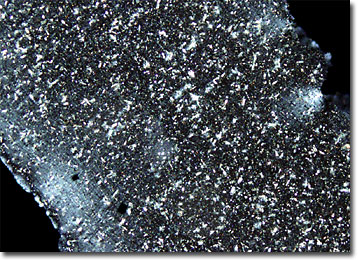Polarized Light Microscopy Digital Image Gallery
Bituminous Coal
Bituminous coal is the most prevalent form of coal on Earth. Most of this important natural resource was formed some 280 to 345 million years ago during the Carboniferous period, but many deposits were produced during various other eras of geologic history as well.

In the series of carbonaceous fuels that ranges from peat to anthracite, bituminous coal is of middle rank, containing intermediate amounts of fixed carbon, volatile material, and moisture in comparison with the other materials to which it is related. Bituminous coal also exhibits a relatively high heat value, which along with its abundance, is responsible for its common use in a number of important practical applications. The material is, for instance, utilized to generate steam in industrial plants and to produce coke for the smelting of iron ore, two functions that are central to modern civilization. Unfortunately, however, burning sizable quantities of sulfur-containing bituminous coal can have an adverse effect on the environment, leading to such detrimental effects as air pollution and acid rain. Due to these considerable problems, some electric power plants have begun utilizing the less environmentally damaging subbituminous coal instead, and scientists are in constant pursuit of even better sources of fuel.
Coal is formed through the long-term alteration of organic matter. The first step of this process involves the decomposition of plant material by bacteria and other microorganisms, which results in peat. When this peat is subjected to immense amounts of pressure, generally stemming from the accumulation of rocks, sediments, and other material that form layers atop of the plant matter, the material undergoes metamorphism as some of its original water and volatile substances are lost. The result of this metamorphism is a more compact material that may be lignite or coal, the latter of which develops under larger amounts of physical force. Furthermore, the greater the stress undergone during the process of metamorphism, the higher the grade of coal that is produced.
